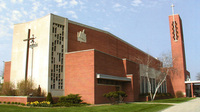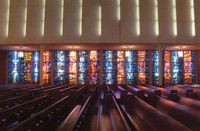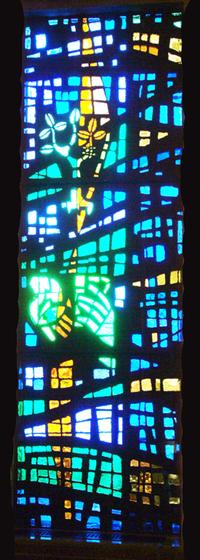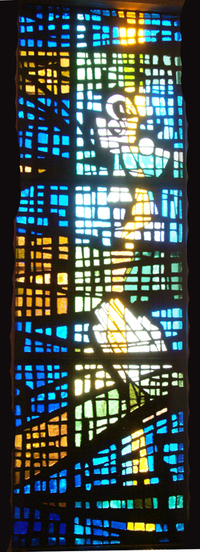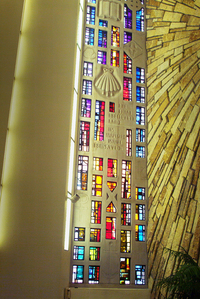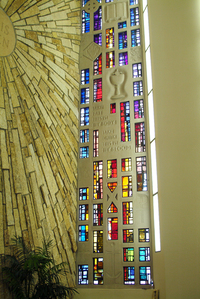MSGC : Featured Windows : Current Window
Featured Windows, March-April 2009
St. Paul Lutheran Church
Building: St. Paul Lutheran Church
City: Flint
State: Michigan
St. Paul Lutheran Church, Flint, MI. Built 1959. Earl L. Confer, Detroit, MI, architect.
St. Paul Lutheran Church was organized in 1909. Its present church home, designed in a contemporary style by Earl L. Confer of Detroit, was constructed in 1959. The church is celebrating the centennial anniversary of its founding and the fiftieth anniversary of its present building throughout 2009.
Sixteen windows on the right side of the sanctuary represent the life and writings of St. Paul. Sixteen more windows on the opposite wall represent other events and writings in Paul’s life. St. Paul Lutheran Church, Flint, MI. Benoit Gilsoul, Willet Stained Glass Studios, Philadelphia, PA. 1964-1968.
Thirty-two faceted glass windows on the side aisles of the sanctuary were installed between 1964 and 1968. They are based on the life and ministry of the Apostle Paul, as recorded in the Book of Acts and the Epistles of Paul. Two additional windows on either side of the chancel, installed in 1984, symbolize the Holy Sacraments of baptism and communion. The windows on the side aisles were designed by Benoit Gilsoul; the two chancel windows are by Charles Z. Lawrence. All of the windows were fabricated by the Willet Stained Glass Studios of Philadelphia, PA.
Willet Stained Glass Studios was founded by William Willet (1867-1921) with his wife, Anne Lee Willet (1867-1943). First located at Pittsburgh in 1898, the studio has been active at Philadelphia since 1913. It has created countless windows for churches and cathedrals across the country, including many windows in Michigan. Henry Lee Willet took over the studio after his father’s death. In a 1977 letter to the church, he recalled the project as one of the most interesting commissions his studio had ever undertaken. Because the church building was non-traditional in style, Willet had recommended the use of faceted glass, or dalles de verre, a new 20th-century technique that the studio began to use in the 1950s. Pastor Theodore Zeile and the congregation’s planning committee were closely involved with the studio in selecting the iconography. In 1977, Willet Stained Glass Studios became a division of the Hauser Art Glass Company based in Winona, Minnesota, and its name was changed to Willet Hauser Architectural Glass.
Born in Namur, Belgium, Benoit Gilsoul (1914-2000) graduated from the Academie des Beaux-Arts in 1938. After coming to the United States in the early 1960s, he designed windows for many churches and synagogues, as well as the United Nations building in New York City. Charles Z. Lawrence learned the art of stained glass as an apprentice to the German master Rudolph H. Buenz and through study at the Pratt School of Design in New York. He has worked for major studios, including the Willet Stained Glass Studios, and opened his own studio in the 1980s. Both men have designed windows for the Washington National Cathedral.
The thirty-two windows on the sanctuary walls provide an unusual faceted glass record of St. Paul’s life and work. The windows have alternating warm and cool color schemes. Those in reds and golds portray the life of St. Paul as described in the Book of Acts. The windows with predominant greens, blues and purples symbolize his spiritual life and writings found in the Epistles of Paul. Eight of the thirty-two windows related to the life of St. Paul are shown here, in addition to the two windows near the altar.
Four of sixteen windows on the left side of the sanctuary. St. Paul Lutheran Church, Flint, MI. Benoit Gilsoul, Willet Stained Glass Studios, Philadelphia, PA. 1964-1968.
At the left is an image of St. Paul in chains, a reference to his imprisonment at Rome (Ephesians 6:19-20). In the next window, a lamb symbolizes the Christian surrounded by the love of Christ (Romans 8:35-37). The third window depicts the disciple Ananias restoring the sight of St. Paul, who had been blinded by a vision while traveling to Damascus (Acts 9:10-18). In the upper part of the window at far right, an olive tree, representing the community of believers, bears a grafted branch to replace a branch broken off because of unbelief (Romans 11:16-21). Below, two hands hold a fish and a cup, symbolizing St. Paul’s admonition to give food and drink to one’s enemies (Romans 12:20).
Four of sixteen windows on the right side of the sanctuary. St. Paul Lutheran Church, Flint, MI. Benoit Gilsoul, Willet Stained Glass Studios, Philadelphia, PA. 1964-1968.
The upper part of the window at the left depicts two cups, the chalice and wafer of Holy Communion and the “devil’s cup” holding a serpent, symbol of evil, to illustrate St Paul’s warning that the Christian cannot drink from both cups, i.e., serve both God and worldly gain (I Corinthians 10:21); below are hands folded in expectation, a reference to John the Baptist’s prophecy of the coming Christ, as related by St. Paul (Acts 13:25). In the next window, the imprisoned St. Paul is encouraged by a vision of Christ (Acts 23:11). The third window holds images of three churches with differing architecture, representing various forms of Christianity that have followed the teachings of St. Paul. In the far right window, St. Paul is shown as the founder of churches, his left hand holding a small building while his right hand is raised in blessing over the fruits of his missionary work.
The Baptism and Communion Windows. St. Paul Lutheran Church, Flint, MI. Charles Z. Lawrence, Willet Stained Glass Studios, Philadelphia, PA. 1984. A window on the left side of the chancel symbolizes the Holy Sacrament of baptism, with an image of a shell and related inscription carved into the stonework. A similar window on the right of the chancel represents the Holy Sacrament of communion, with images of a chalice and wafer and a related inscription carved into the stone. The stonework was created when the church was built in 1959; the glass was added in 1984.
St. Paul Lutheran Church was registered in the Michigan Stained Glass Census by Robert T. Florine of Swartz Creek, MI, with photography by Derek Orme.
Bibliography:
Show BibliographyCrimi, Elody R. and Diane Ney. Jewels of Light: the Stained Glass of the Washington National Cathedral. Washington, D.C.: Washington National Cathedral, 2004.
The Holy Bible, King James Version. (New York: American Bible Society, 1999). Published May 2000 by Bartleby.com; ©Copyright Bartleby.com, Inc.
Jones, Robert O. Biographical Index of Historic American Stained Glass Workers. Kansas City, MO: Stained Glass Association of America, 2002.
Letter to St. Paul Lutheran Church from Henry Lee Willet, Chairman, Willet Stained Glass Studios, dated August 17, 1977.
Raguin, Virginia Chieffo. Reflections on Glass – 20th Century Stained Glass in American Art and Architecture. New York: American Bible Society, 2003.
Raguin, Virginia Chieffo. Stained Glass: From its Origins to the Present. New York: Harry N. Abrams Publishing Company, 2003.
St. Paul Lutheran Church, Flint, Michigan. “The Life of St. Paul.” Booklet describing the windows, n.d.
Willet Hauser Architectural Glass. “Willet Studios.” http://www.willethauser.com/aboutwh/ourstory/willet.asp(MSGC 1997.0094)
Text by Betty MacDowell, Michigan Stained Glass Census, March , 2009.

